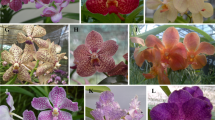Abstract
Tuber morphology and propagation efficiency in three dioecious, tuber bearing Momordica species of India were investigated. Tuber morphology of M. dioica and M. sahyadrica is different from that of M. subangulata ssp. renigera. M. dioica and M. sahyadrica develop taproot tuber with shoot sprouts only at caudex region, whereas M. subangulata ssp. renigera has both taproot and adventitious tubers with shoot sprouts all over tuber surface. Tubers of M. dioica and M. sahyadrica are perennating whereas, in M. subangulata ssp. renigera they serve as both perennating and propagation structures. M. dioica and M. sahyadrica had prolonged tuber dormancy of 4–5 months whereas, M. subangulata ssp. renigera had short dormancy period of about 2 months. Cutting of tuberous roots is a highly efficient method for multiplication in M. subangulata spp. renigera, whereas whole tubers or longitudinal splits in to two or at best four equal halves with a portion of the apical meristem may work in the case of M. dioica and M. sahyadrica.




Similar content being viewed by others
References
Allemann J, Robbertse PJ, Hammes PS (2003) Organographic and anatomical evidence that the edible storage organs of Plectranthus esculentus N.E.Br. (Lamiaceae) are stem tubers. Field Crops Res 83:35–39. doi:10.1016/S0378-4290(03)00054-6
Artschwager E (1924) On the anatomy of the sweet potato root, with notes on internal breakdown. J Agric Res 27:157–166
De Wilde WJJO, Duyfjes BEE (2002) Synopsis of Momordica (Cucurbitaceae) in South East Asia and Malaysia. Bot Zhurn 57(3):132–148
Joseph John K (2005) Studies on ecogeography and genetic diversity of the genus Momordica L. in India. PhD thesis, Mahatma Gandhi University, Kottayam, Kerala, India
Joseph John K, Antony VT (2007a) Momordica sahyadrica sp. nov. (Cucurbitaceae), an endemic species of Western Ghats of India. Nord J Bot 24(5):539–542
Joseph John K, Antony VT (2007b) Ethnobotanical investigations in the genus Momordica L. in the Southern Western Ghats of India. Genet Resour Crop Evol 54(6):1327–1332. doi:10.1007/s10722-007-9279-5
Joseph John K, Antony VT, Roy YC (2006) On the occurrence, distribution and taxonomy of Momordica subangulata Blume ssp. renigera (G. Don) de Wilde in India. Genet Resour Crop Evol 54(6):1327–1332. doi:10.1007/s10722-006-9114-4
Kerbs CJ (1972) Ecology: the experimental analysis of distribution and abundance. Harper and Row, New York
McCormick FA (1916) Notes on the anatomy of young tuber of Ipomea batatas Lam. Bot Gaz 61:388–398. doi:10.1086/331794
Metcalfe CR, Chalk L (1957) Anatomy of the dicotyledons, vol 2. Oxford Publishers, Oxford
Mishra KC, Sahu RP (1983) Large scale cultivation of small bitter gourd, problems and possibilities. Indian Hortic (Oct–Dec.):5–8
Mishra KC, Sahu RP, Jha UC (1988) Balsam apple for your vegetable garden. Indian Hortic 30(4):13
Pascual B, Maroto JV, San Bautista A, Alagarda J, López-Galarza S (2003) Morphological and productive characteristics of nine “chufa” (Cyperus esculentus L. var. sativus Boeck.) clones. Acta Hortic 614(1):85–88
Ram D, Banerjee MK, Pandey S, Srivastava U (2001) Collection and evaluation of kartoli (Momordica dioica Roxb. ex Willd.). Indian J Plant Genet Resour 14:114–116
Ram D, Kalloo G, Banerjee MK (2002) Popularizing kakrol and kartoli: the indigenous nutritious vegetables. Indian Hortic 9:6–9
Sass JE (1951) Botanical microtechnique. Iowa State University Press, Ames
Unni PN, Raghavan P, Philip VJ (1976) A histopathological study of anomalous growth in the stem of Coccinia indica W. & A. infested with Neolasioptera cephalandrae Mani. Ann Bot (Lond) 40:493–497
Wilson LA (1973) Stimulation of adventitious bud production in detached sweet potato leaves by high levels of nitrogen supply. Euphytica 22:324–326. doi:10.1007/BF00022641
Wilson LA, Lowe SB (1973) The anatomy of the root system in West Indian sweet potato (Ipomoea batatas (L.) Lam.) cultivars. Ann Bot (Lond) 37:633–643
Ye Z-H (2002) Vascular tissue differentiation and pattern formation in plants. Annu Rev Plant Biol 53:183–202. doi:10.1146/annurev.arplant.53.100301.135245
Author information
Authors and Affiliations
Corresponding author
Rights and permissions
About this article
Cite this article
Joseph John, K., Antony, V.T., Marydas, J. et al. Tuber morphology, germination behaviour and propagation efficiency in three edible Momordica (Cucurbitaceae) species of India. Genet Resour Crop Evol 56, 861–868 (2009). https://doi.org/10.1007/s10722-009-9407-5
Received:
Accepted:
Published:
Issue Date:
DOI: https://doi.org/10.1007/s10722-009-9407-5




